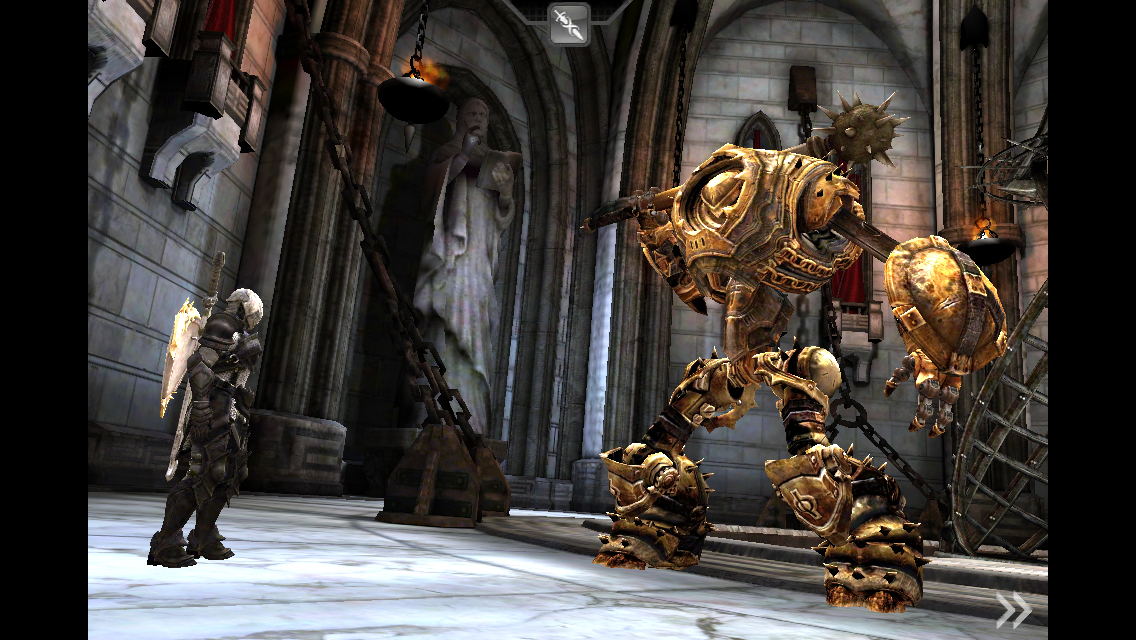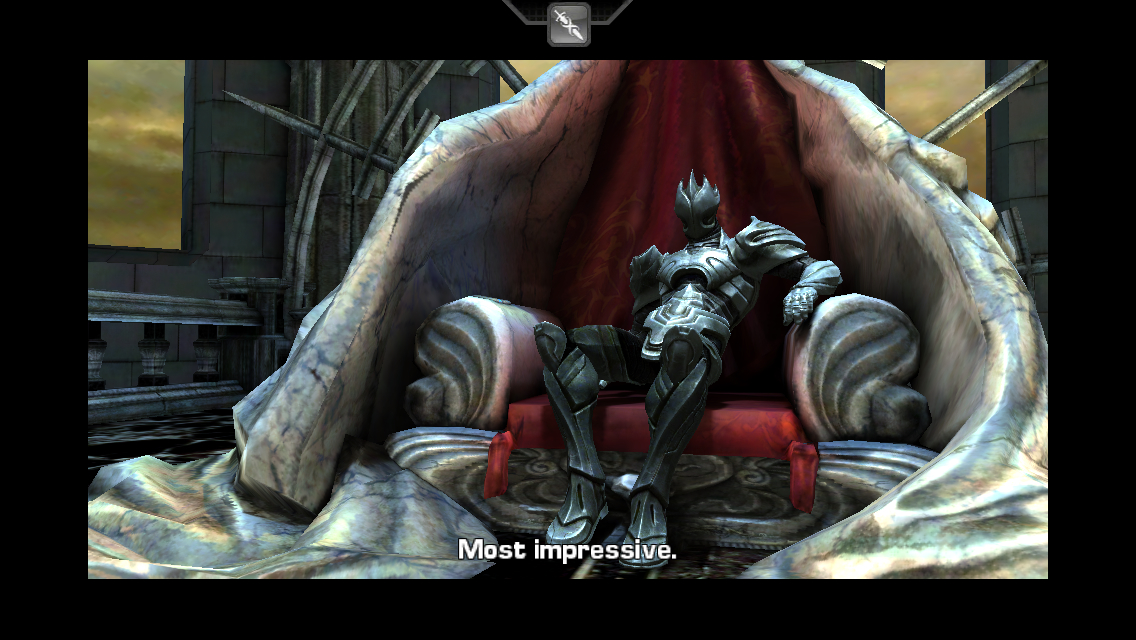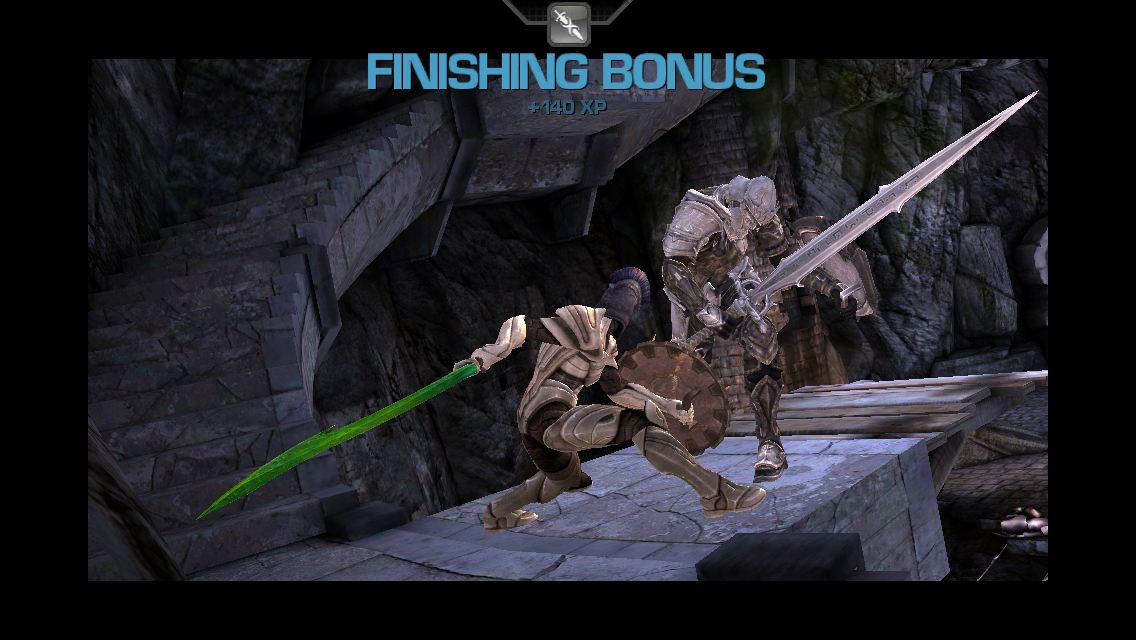 Hello, gentle readers, and welcome to the RPG Reload, the weekly feature where we don’t ask how dad’s gear gets back to his family every time. Each week, we take a look at an RPG from the App Store’s past to see how it holds up in the modern day. It’s a little revisiting, a little reflecting, and a chance to take a deeper dive than our reviews typically allow for. As the host of this little program, I try to choose a wide variety of RPGs from week to week, but I need your help to make sure I’m not missing anything. That’s why once per month, I turn the selection to you. Simply make your suggestion known by commenting below, posting in the Official RPG Reload Club thread in the forums, or by tweeting me at @RPGReload. Since June’s reader’s choice has already been decided, any votes at this point will go towards the July reader’s choice. The next reader’s choice, coming up next week, is Guardian Saga ($0.99).
Hello, gentle readers, and welcome to the RPG Reload, the weekly feature where we don’t ask how dad’s gear gets back to his family every time. Each week, we take a look at an RPG from the App Store’s past to see how it holds up in the modern day. It’s a little revisiting, a little reflecting, and a chance to take a deeper dive than our reviews typically allow for. As the host of this little program, I try to choose a wide variety of RPGs from week to week, but I need your help to make sure I’m not missing anything. That’s why once per month, I turn the selection to you. Simply make your suggestion known by commenting below, posting in the Official RPG Reload Club thread in the forums, or by tweeting me at @RPGReload. Since June’s reader’s choice has already been decided, any votes at this point will go towards the July reader’s choice. The next reader’s choice, coming up next week, is Guardian Saga ($0.99).
This week is the last entry in the May theme of light RPGs. The goal here was to offer some good RPGs to play when you’re on the go or outside enjoying the lovely weather. As it’s starting to get too hot already, next month we’ll be switching back to RPGs that can be appreciated while you sit two inches away from an electric fan. I initially didn’t think Infinity Blade ($5.99) was a good fit for the RPG Reload, because it feels more like an action game than anything else. Someone made a pretty passionate case for the game to me, though, and in the end I really couldn’t deny that it’s got a lot of RPG in its genes. This isn’t to say I’m looking to expand this column to include every game that features any sort of RPG mechanics, but in the context of light RPGs, I think Infinity Blade is worth mentioning.

Released in December of 2010, Infinity Blade might just take the cake as the most-hyped iOS game of all-time. It was the first iOS game to use the Unreal engine, and its shiny graphics were a big part of its marketing. I even remember seeing people using screens of the game to make a mockery of certain other pieces of gaming hardware. Though the comparisons were unfair for a variety of reasons, there’s no doubt that Infinity Blade had a serious “wow" factor to it. Apple used it as a centerpiece at their September 2010 press event, and it figured heavily into their advertising for a while after. Nobody had seen anything that looked that good running on handheld hardware before. This is, of course, exactly as it was meant to be, and something developer Chair Entertainment’s parent Epic Games was no stranger to.
Epic Games makes games, of course. But in recent times, their biggest business is in licensing out their game engines. To really draw attention, it can’t hurt to have a showpiece, and Epic has never had any trouble providing them. Their first version of the Unreal Engine was nicely demonstrated by Unreal itself. To show off how well Unreal Engine 3 could run on consoles, they developed Gears Of War. When it came time to demonstrate how well Unreal Engine 3 could work on iOS, Epic turned to their subsidiary company Chair Entertainment. They gave the developer five months to develop the game, with a playable demo required for Apple’s presentation in just two months. The development team had released a couple of Xbox Live Arcade titles, including the outstanding Shadow Complex, and had been toying around with ideas for Microsoft’s new Kinect peripheral. One of those was a fantasy sword-fighting game, presumably asking the player to move their arms to pantomime the actions. They quickly realized that this idea would work out pretty well on touch screens.
The basic structure of the game is an ode to games like Karateka ($0.99), a classic fighting game where you more or less traveled from one one-on-one fight to the next in order to rescue a princess. In terms of atmosphere, the game was apparently informed by the isolated feeling of Team ICO’s Shadow Of The Colossus. Of course, most fans didn’t know this when the game was demonstrated at Apple’s keynote as Project Sword. They just knew it looked amazing and they wanted it. While some may have been disappointed with the game’s limited scope when its true nature became apparent, far more people loved the game anyway. Developed by a team of just 12 people in a handful of months, it was an incredible financial success, selling more than 270,000 copies in its first four days and kicking off a franchise that would pull in tens of millions of dollars. The game would go on to inspire two proper sequels, an arcade port, a canceled spin-off, and a number of books. Chair Entertainment has said that Infinity Blade 3 ($6.99) is the last entry in the series, but I wouldn’t be surprised if turns up again in some form or another.

The skeleton of the game doesn’t venture far from the idea of Karateka. Though there is no princess awaiting us, we simply move from one fight to the next. We have to make the choice to continue on, and unlike Karateka, we occasionally have a couple of paths to choose from, but eventually all roads lead to royalty: the God King, the being that killed our father, and potentially any number of fathers of fathers before him. One way or another, it ends in that throne room. Maybe we’ll win, maybe we’ll lose, or maybe we’ll throw down your sword and join him. At least, that’s how the game was in its original release. A major content drop that arrived later added another possible path to take, adding to the lore and giving another potential ending. No matter what, the adventure will be short. There may have been all manner of exciting events leading up to where we take control of our character, but we’re only there for the climax. We’ll fight a few big creatures, challenge a final boss, and that’s that.
Other than a bit of tapping around for navigation and picking up treasure, all of the gameplay happens in the fights. Here, it’s less Karateka and more Punch-Out!. There are a few different types of enemies who come in a variety of guises, and each type has several different patterns they’ll use in battle. Like in Nintendo’s boxing game, your job is mostly to learn those patterns and react to them. Dodging here, blocking there, striking when the moment is right, and if you feel particularly confident, parrying the incoming blows. Tapping at either side of the screen will dodge in that direction, touching the shield icon in the bottom-center blocks, and swiping attacks. To parry, you need to counter the enemy’s strike with an opposing motion at the right time. This will temporarily stagger the enemy and give you a chance to stun them. In addition to these basic moves, you can also use a special attack that instantly stuns the opponent, or cast a spell by drawing a shape. Each of these moves are on separate cooldown timers, so you can only use them once in a while.
The God King is the final boss, and he’s quite a challenge. As this is ultimately a game of reflexes, you could probably beat him on your first try if you avoid getting hit and don’t mind spending a ton of time whittling him down. You’re meant to die, though, leaving your son to follow in your footsteps. This is where the RPG part comes into play. Infinity Blade is a pretty short game, and if it had to rely on players coming back just to do the same seven or eight fights again and again, I doubt it would have gone over as well. RPG elements to the rescue! Each fight will earn you some experience points, though the way the game handles it is pretty unusual. You have five equipment slots, and each different type of gear has a pool of experience points to fill up. When it hits its limit, its portion of the experience will no longer go towards your character’s overall level, so you’re encouraged to replace it if you want to get stronger. Mastering gear and leveling up earns you bonus points you can apply towards your hit points, attack power, shield power, and magic power. These stat upgrades will make it easier to survive the battles, so you’ll want to make sure the experience points keep coming in.

That means you constantly need to pick up new gear, either by being lucky enough to find it or by buying it from the shop with your accumulated gold. Gear pieces often have effects in and of themselves, like increasing item or gold drops, inflicting poison, and so on. Rings in particular have important differences, as they determine which magic spells you have access to. These properties mean that even after a piece is maxed out and can’t offer you any more experience points, you might still want to use it for certain battles. Of course, as you play you’ll also likely hit points where you can’t afford the next upgrade, so you’ll have to stick with old gear and the reduced growth that comes with it until you can. With the game being as short as it is, all of this would be for naught if you lost everything in the God King’s chamber each time. Luckily, our hero is wise enough to father some children before he goes on his suicidal mission, and the God King is a true gentleman about Fed Exing his gear back to his family. While I can’t come up with a clever explanation for it, your experience and stats also carry over to the next generation, meaning you start anew in the state that your previous character left off.
Almost every piece of gear serves simply to make you stronger, but there’s one piece in particular you’ll want to get your hands on for story purposes. In what is frankly an amazing find for the shopkeeper, the titular Infinity Blade is sitting in the shop, waiting to be purchased for a good 514,900 gold. With that sword in hand, you can open up a special new area with a few extra boss fights against the Deathless Kings. If you can beat them all, you’ll learn some new information about the Deathless and your own family. There isn’t a lot of story in the game, to be sure, but what’s here is intriguing enough to pique one’s curiosity. If you beat the God King, you’ll learn a little bit. If you beat the Deathless, you’ll learn something else. The rest is left to your imagination until you jump into the books or sequels. Each pass through the story, the enemies get a bit tougher, the rewards increase a little more, your character gets a touch stronger, and your odds of winning get a bit higher. I’d imagine most players should be able to beat the God King within 10 runs, give or take, but saving up for the Infinity Blade to get the other ending will probably take some time.
Part of the fun of the game is seeing what each new piece of gear does, both in terms of its effects and how it makes your character look. Chair wasn’t afraid to throw in some goofy options, like a sword that looks like a severed pointer finger, and references abound to things like Captain America’s shield or Cobra Commander’s hood. Certain categories have more options than others, so you’ll be changing your sword and helmet a lot more frequently than your armor, for example. Because of this, your character tends to look like a bit of a patchwork knight, but if you’re really interested in fashion, you can always ignore effects and put together a cool ensemble. You’ll just need to improve your skills enough to get away with it.

Not that that’s all that difficult, mind you. Infinity Blade is a gorgeous game, and it’s a lot of fun in short bursts, but the game was built in a very short period of time, after all. While the sequels would add a lot more complexity to the whole affair, the first game is pretty simple. There aren’t very many types of enemies, and they have a very small number of tells to learn. Once you sort out each one’s elemental weakness and have a selection of rings and swords to swap out, it’s almost trivial to beat most of them, no matter what their stats look like. It reaches a point where playing too much of it at a time starts to feel a bit grindy, especially when you start to slow down on picking up new gear. As something you pull out now and then, it’s still pretty fun, and even if you manage to max out all the gear after a while, you can always do a New Game+ and start the whole process again with your level intact but all the gear pieces set back to their original states.
In the end, the game received four major updates and three minor patches, with the last update of any sort released in February of 2012. The major updates included new gear, new enemies, the New Game+ mode, the multiplayer Arena mode, additional character slots, increases in the level cap, and the Deathless Kings optional content. The Arena mode is interesting, I suppose, but I never really got much into it. The rest of the content is of course quite welcome and greatly extended the life of the game. Given the date of the last update, I imagine we won’t be seeing another one unless things totally break. That means we’re unlikely to see things like support for MFi controllers, the larger screens of the iPhone 5 and up, and so on. Other than that, the game still runs just fine, and it’s remarkable how even nearly five years later, it’s still quite the looker.
As a game, Infinity Blade has definitely been surpassed by its sequels, but in terms of impact, I’d go so far as to say that no other iOS game has since matched it. Infinity Blade finally gave iOS an exclusive game that no one ignore. People who hadn’t given the platform a second look before were talking about it, and it proved that a high-quality, premium experience could not only survive but thrive in the ecosystem. Five years is a really long time, I suppose. While the game does little to scratch the itch for adventuring, it certainly provides plenty of character raising and equipment hoarding, two staples of any RPG fan’s diet. While I think most people will prefer to play one of the later games, the first Infinity Blade is still pretty fun to play, offering a great jumping-off point to get into the series.

That’s just my take on Infinity Blade, though. What are your thoughts? Leave a comment below, post in the Official RPG Reload Club thread in the forums, or tweet me at @RPGReload to let me know what you think. Don’t forget to throw in a suggestion or two for the next reader’s choice while you’re at it. I should also mention that the latest episode of the RPG Reload Podcast should be ready to go next Monday. Eric Ford, special guest Andrew Fretz, and I have a big discussion about Final Fantasy 4 ($14.99), so make sure to check it out! As for me, I’ll be back next week to talk about Guardian Saga. Thanks for reading!
Next Week’s Reload: We check out the oddly familiar Guardian Saga!